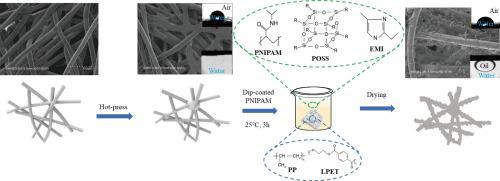当前位置:
X-MOL 学术
›
Prog. Org. Coat.
›
论文详情
Our official English website, www.x-mol.net, welcomes your
feedback! (Note: you will need to create a separate account there.)
Facile fabrication of hydrophilic-underwater superoleophobic poly(N-isopropylacrylamide) coated PP/LPET nonwoven fabrics for highly efficient oil/water separation
Progress in Organic Coatings ( IF 6.5 ) Pub Date : 2020-11-01 , DOI: 10.1016/j.porgcoat.2020.105780 Fei Sun , Ting-Ting Li , Xiayun Zhang , Bing-Chiuan Shiu , Yue Zhang , Hai-Tao Ren , Hao-Kai Peng , Jia-Horng Lin , Ching-Wen Lou
Progress in Organic Coatings ( IF 6.5 ) Pub Date : 2020-11-01 , DOI: 10.1016/j.porgcoat.2020.105780 Fei Sun , Ting-Ting Li , Xiayun Zhang , Bing-Chiuan Shiu , Yue Zhang , Hai-Tao Ren , Hao-Kai Peng , Jia-Horng Lin , Ching-Wen Lou

|
Abstract Oil/water separation has become an urgent issue in environmental protection. Superhydrophilic and underwater superoleophobic membrane is promising materials for effective oil/water separation. In this paper, a novel oil/water separation nonwoven fabric with robust tensile strength and hydrophilic-underwater superoleophobic is successfully fabricated. This nonwoven fabric using low melt point polyester (LPET) fibers with a unique sheath-core structure to incorporate thermal bonding as reinforcement. Moreover, poly(N-isopropylacrylamide) (PNIPAM) dip-coated is also employed to modify the nonwoven fabrics to acquire the hydrophilic-underwater superoleophobic properties. The mechanical property, microstructure, water and underwater oil contact angle, and oil/water separation properties of PP/LPET nonwoven fabrics are measured, examining the effects of LPET fiber ratio and PNIPAM concentration. The test results show that an improvement in the mechanical properties after increasing the LPET content. The coated of PNIPAM endows the nonwoven fabric with a low water contact angle of from 80 ° to 0 ° (within 8 s), and underwater superoleophobicity with a high oil contact angle of 150 ° . This nonwoven fabric can effective separation oil/water mixture with high permeate flux (∼21850 L ∙ m−2 ∙ h−1) and high separation efficiency (∼99%), solely driven by gravity. This kind of nonwoven fabrics is suggested as a promising candidate for oil/water separation and water purification.
中文翻译:

亲水-水下超疏油聚(N-异丙基丙烯酰胺)涂层PP/LPET无纺布的简易制造,用于高效油/水分离
摘要 油水分离已成为环境保护中亟待解决的问题。超亲水和水下超疏油膜是有效油/水分离的有前途的材料。在本文中,成功地制备了一种具有强大拉伸强度和亲水-水下超疏油性的新型油水分离无纺布。这种无纺布使用低熔点聚酯 (LPET) 纤维,具有独特的皮芯结构,将热粘合作为增强材料。此外,还采用浸涂的聚(N-异丙基丙烯酰胺)(PNIPAM)对非织造布进行改性,以获得亲水-水下超疏油性能。测量PP/LPET无纺布的力学性能、微观结构、水和水下油接触角、油水分离性能,检查 LPET 纤维比率和 PNIPAM 浓度的影响。测试结果表明,增加LPET含量后机械性能有所改善。PNIPAM的涂层赋予无纺布80°至0°(8s内)的低水接触角,以及150°的高油接触角的水下超疏油性。这种无纺布可以有效分离油/水混合物,具有高渗透通量(~21850 L ∙ m-2 ∙ h-1)和高分离效率(~99%),完全由重力驱动。这种无纺布被认为是油/水分离和水净化的有希望的候选材料。PNIPAM的涂层赋予无纺布80°到0°(8s内)的低水接触角,以及150°的高油接触角的水下超疏油性。这种无纺布可以有效分离油/水混合物,具有高渗透通量(~21850 L ∙ m-2 ∙ h-1)和高分离效率(~99%),完全由重力驱动。这种无纺布被认为是油/水分离和水净化的有希望的候选材料。PNIPAM的涂层赋予无纺布80°至0°(8s内)的低水接触角,以及150°的高油接触角的水下超疏油性。这种无纺布可以有效分离油/水混合物,具有高渗透通量(~21850 L ∙ m-2 ∙ h-1)和高分离效率(~99%),完全由重力驱动。这种无纺布被认为是油/水分离和水净化的有前途的候选材料。
更新日期:2020-11-01
中文翻译:

亲水-水下超疏油聚(N-异丙基丙烯酰胺)涂层PP/LPET无纺布的简易制造,用于高效油/水分离
摘要 油水分离已成为环境保护中亟待解决的问题。超亲水和水下超疏油膜是有效油/水分离的有前途的材料。在本文中,成功地制备了一种具有强大拉伸强度和亲水-水下超疏油性的新型油水分离无纺布。这种无纺布使用低熔点聚酯 (LPET) 纤维,具有独特的皮芯结构,将热粘合作为增强材料。此外,还采用浸涂的聚(N-异丙基丙烯酰胺)(PNIPAM)对非织造布进行改性,以获得亲水-水下超疏油性能。测量PP/LPET无纺布的力学性能、微观结构、水和水下油接触角、油水分离性能,检查 LPET 纤维比率和 PNIPAM 浓度的影响。测试结果表明,增加LPET含量后机械性能有所改善。PNIPAM的涂层赋予无纺布80°至0°(8s内)的低水接触角,以及150°的高油接触角的水下超疏油性。这种无纺布可以有效分离油/水混合物,具有高渗透通量(~21850 L ∙ m-2 ∙ h-1)和高分离效率(~99%),完全由重力驱动。这种无纺布被认为是油/水分离和水净化的有希望的候选材料。PNIPAM的涂层赋予无纺布80°到0°(8s内)的低水接触角,以及150°的高油接触角的水下超疏油性。这种无纺布可以有效分离油/水混合物,具有高渗透通量(~21850 L ∙ m-2 ∙ h-1)和高分离效率(~99%),完全由重力驱动。这种无纺布被认为是油/水分离和水净化的有希望的候选材料。PNIPAM的涂层赋予无纺布80°至0°(8s内)的低水接触角,以及150°的高油接触角的水下超疏油性。这种无纺布可以有效分离油/水混合物,具有高渗透通量(~21850 L ∙ m-2 ∙ h-1)和高分离效率(~99%),完全由重力驱动。这种无纺布被认为是油/水分离和水净化的有前途的候选材料。











































 京公网安备 11010802027423号
京公网安备 11010802027423号